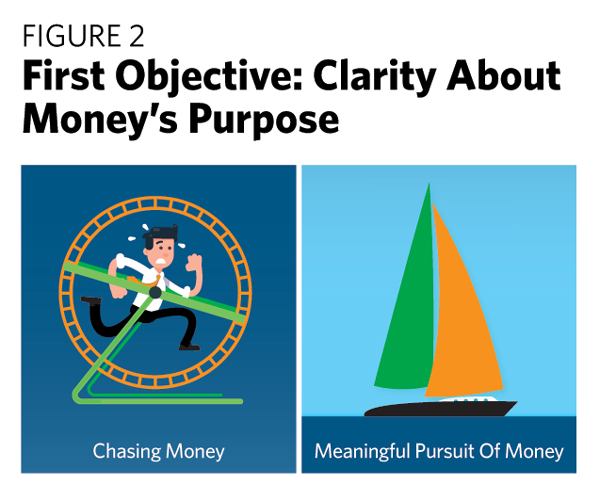First Objective: Clarity About Money’s Purpose
There is a point to having money. There is a purpose for gathering wealth. Too often, wealth managers focus on growing the tree instead of harvesting and building with the timber. Yet the conversation about money’s purpose is grossly neglected in the average planning dialogue. “What is the money for?” may be the simplest and most necessary question you ask.

To help your clients with this discussion, you need to put forth a point of view on what the money is all about. Wear the philosopher’s hat and explain that you understand the bigger picture, the more meaningful aspect, what matters most—that there is meaning attached to their means and that there is purpose attached to their purse.
The Figure 2 graphic has proved to be a great stimulus to such a conversation, helping life-centered planners explain the difference between chasing money and pursuing a meaningful objective with it.
Everyone knows people who feel like the gerbil in the wheel when they are just chasing money, not knowing what will happen if they ever catch it. The sail represents a different philosophy: Money is nothing more than something we use to navigate. It is not the shore we sail for, the water we sail upon, or even the vessel that transports us and our loved ones. It’s just a utility. Yet it must be managed skillfully if we hope to arrive safely.
Second Objective: The Story Behind The Numbers
Advisors who rethink their value in these terms must also master the art of learning their clients’ stories. That will not only help us make a personal connection, but lead us to planning that’s more precise.
Graphics like the one in Figure 3 illustrate for the client that your process isn’t one-size-fits-all—that it’s deeply personalized. The outer circle represents what we might call “money mechanics” or the necessary focuses of a financial planning process. Many of those functions can be replicated by technology and imitated by poseurs in planning. Once we are on the same page with the client that the primary objective is a greater “return on life,” then the work comes to be about personal discovery—not just of their assets but of their story: past, present and future.
Shakespeare wrote in The Tempest, “What’s past is prologue.” We need to know of our clients’ experiences with money, because contained in those experiences are the blueprints for their financial status and potential future. We also need to understand clients’ experiences with other financial professionals, good or bad, as those too have a bearing on the risks they will or will not be willing to take.








